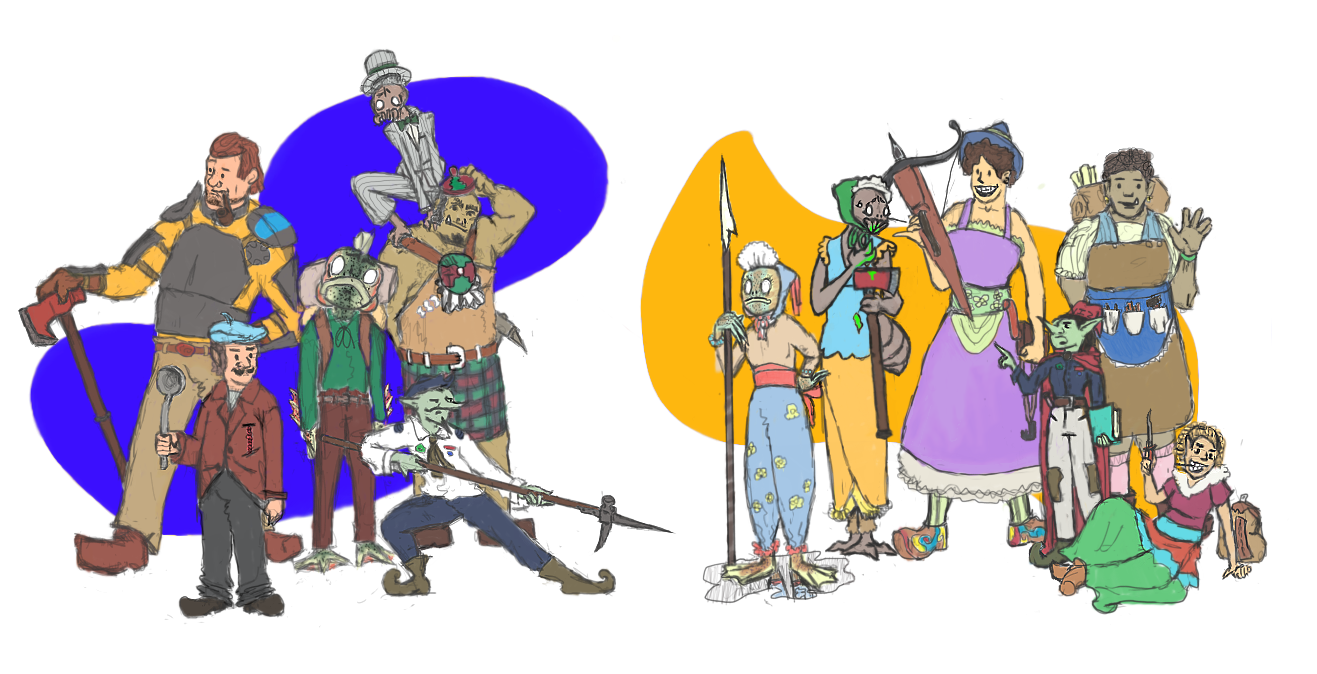Human
The subraces of Humans which, together, seek to seize Bloodmarsh back from the savage Immortals. Regular Mortals have been taking ship from the Western Continent into the Crotch to help with The Taking, which has the fatalistic flavor of a Crusade, with the same dim promise of looted riches. These immigrants are the Tallboys and Lowhuts, who are fast friends and close cousins in ancestry, as well as the Goblins, who keep to their own much more but respect what strength and honor the other races show.
Endemic to the Crotch and pushing south and seaward from the inland mountains are the Bighornians, whose ancient ancestry carries the last remains of the bloodlines of the Orks, now functionally extinct. Finally, joining some from overseas and some from native fastnesses, are the Screwbros - magically mutated humans with animal affinities and seriously shortened lifetimes. These are the fishy Locathah and the spider-like Ettercaps, both of which races are quite aware of their weirdness and quite salty about it. Especially Locathah. They live in the ocean, you see.
The species composed of Humans and their mutant relatives, the Screwbros. All mundane folk eat food, breathe, sleep, and die for no reason after just a few decades. The subspecies include:
Subspeciation and Taxonomy
Each subrace is descended from the same original human ancestors, known as rootstock humans, plus a small amount of hybridized inheritance from the now-extinct Orks. The differences in the subraces is likely the result of isolation and divergent genetic selection pressures in different parts of the Overlooked Region, often strongly influenced by depredation (or predation) by Immortals of various types. In each entry, you will find the accepted theory of each subrace's origin. The subraces are not categorized as separate species for two reasons. First, they do not satisfy the hybridization definition of speciation. Hybrids of any combination of subrace unions are almost always fertile, though some couplings (Lowhut female and Criminoid male) can present some acute geometrical difficulties during childbirth. Even screwbros are technically subpopulations under this metric, as hybrid offspring have exactly the same rate of fertility as full-blooded children, around 45%. In fact, one survey showed that ettercap-criminoid and locathah-lowhut couples had greater rates of reproductive success than did same-subrace couples of either ettercaps or locathah, approaching 65%. This probably stems from the closer genetic proximity of the two combinations.Courtship and Relations
Selection of spouses is a delicate process fraught with tradition and community pressure. Unlike in more complacent or indolent parts of the Overlooked Regions, where either mortals or immortals are isolated from the other and dwell in relative peace, the survival of communities in Bloodmarsh hinges on community-minded traditions of duty and responsibility. This underlies even the otherwise intensely personal process of courtship. Rural and urban communities alike exhibit arranged marriages with moderate frequency; youths who are not so betrothed are expected by their families to seek a mate who will provide benefits to the whole family and community, whether political, monetary, or just genetic. Youths are therefor almost always married before age 30, and are expected to produce the offspring needed to replace the vast numbers of folk killed in fighting one another or repelling the immortal folk. Social moray discourages infidelity and non-productivity intensely, and enforces a strong family structure. Beyond these general rules, details of courtship and marriage vary based on subrace and geography. Mixed populations often mix or develop their own cultural expectations.Rootstock Humans
Based on fossil evidence, rootstock humans became too derived to be considered distinctly extant about Np 18,000 (around 20,000 years before present). These tall, brawny humanoids were known to be intelligent tool-users and accomplished pack hunters. It is therefor surmised that they arose from some lineage of upright cursorial tetrapod which has no modern descendant; strange that no close cousins to this lineage seem to exist anywhere. Fossils of small, ugly, long-armed humanoids have been found across the Overlooked Regions, but they abruptly disappear from the fossil records around 1 mya.Remove these ads. Join the Worldbuilders Guild









Comments